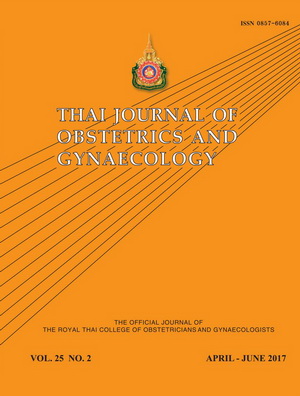The First Aid Solatium Payment Regarding Section 41 of 2002 National Health Security Act in Region 7 during 2012- 2014 for Quality Improvement of the Health System and Guideline to Minimize the Problems in Obstetric and Gynecological Cases
Main Article Content
Abstract
Objectives: To analyze the medical diagnosis that led to payments of the fist aid solatiums (FAS) regarding Section 41 of 2002 National Health Security Act (S41NHSA) in the region 7 of NHS Office (R7NHSO) and the magnitude in both number of cases and amount of money paid. To focus FAS cases and payment in the obstetric specialty which had the greatest part of FAS payment, and to fid out the quality improvement for reducing the problems in obstetric and gynecological cases. The study was done for only during 2012-2014.
Materials and Methods: All of the FAS medical cases records regarding S41NHSA in the R7NHSO during 2012-2014 were collected. The medical diagnosis that led to the fial approval of FAS payment by NHSO was reviewed. The working group of the Sub-Committee to Control the Quality and Standard of the Public Health Service of the R7NHSO had created the guideline to minimize the problems in obstetric and gynecological cases.
Results: The R7NHSO included 4 provinces in the Northeast which are Khon Kaen, Kalasin, Roi Et, and Maha Sarakham. The numbers of FAS payment cases during 2012-2014 were 79, 106, and 110 cases or 295 cases in 3 years. The ratio of S41NHSA complaint per total number of in-patients was low but increasing yearly during this 3 years period. The province with more number of in-patients had a more FAS cases and a more FAS payment. The fie most common FAS payment cases in descending rate were from department of obstetrics (54.38%), surgery (13.9%), medicine (10.5%) pediatric (7.4%) and orthopedics (3.73%). The obstetric department shared the greatest part of FAS payment cases and money. The top fie number of cases (percentage) FAS payment in obstetrics were neonatal death 59 (30.73%), shoulder dystocia 41 (21.35%), unintended pregnancy after tubal ligation 40 (20.83%), maternal death 20 (10.42%) and cerebral palsy 6 (3.13%). The total amount of FAS money paid during the 2012-2014 was 54.68 million Baht for the whole R7NHSO, of which was from Khon Kaen 22.99 million Baht, Kalasin 12.89 million Baht, Roi Et 12.30 million Baht, and Maha Sarakham 6.49 million Baht. The average FAS payment was 185,361.36 Baht/case. The authors suggested 5 items of quality improvement methods to reduce obstetric loss.
Conclusion: The FAS cases and FAS payment in R7NHSO were rising. Most of the FAS cases and payment were from the department of obstetrics. Many diagnoses that caused FAS cases and payments were preventable. A good policy of man power arrangement of obstetricians, a continuously in-service training, and a better incentive for the service providers, the consultation and transferring system of the risky patients should be revised.

